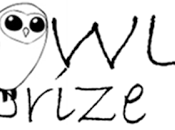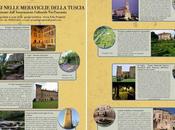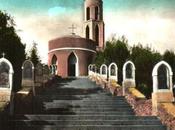
A Fabriano il museo "B. Molajoli", che avevamo visitato una domenica di qualche anno fa in perfetta solitudine, è ora pieno di gente grazie alla mostra che Vittorio Sgarbi ha organizzato intorno all'arco di storia che vede l'eredità determinante di Giotto fino alla grande figura di Gentile da Fabriano dimostrando l'esistenza di una "scuola fabrianese".The museum "B. Molajoli" in Fabriano, which we visited on a Sunday a few years ago in perfect solitude, is now full of people thanks to the exhibition that Vittorio Sgarbi has organized around the arc of history that goes from the determinant legacy of Giotto down to the great figure of Gentile da Fabriano, demonstrating the existence of a "Fabrianese school".

 Due piccoli tondi attribuiti a Giotto: San Francesco e San Giovanni Battista, 1315 ca.Dal sito web della mostra
Due piccoli tondi attribuiti a Giotto: San Francesco e San Giovanni Battista, 1315 ca.Dal sito web della mostraLa mostra aggiunge alla collezione del Museo alcuni pezzi provenienti da altre gallerie e da raccolte private, preziosi per costruire uno scenario artistico emozionante oltre che interessante. Il video in cui Sgarbi lo illustra dà chiavi di lettura chiare e coinvolge il visitatore dentro l'universo culturale e creativo delle opere.
Ci si sente confortati nell'abbandonarci al gusto dei colori e degli ori, delle linee nobili e sinuose, dei visi astratti e intensi, investiti da un distillato di spiritualità ed emozione.The exhibition adds to the Museum some pieces from other galleries and private collections, valuable to construct an artistic scenario both exciting and interesting. The video where Sgarbi illustrates it gives clear interpretations and involves the visitor in the cultural and creative universe of the works.
One feels comforted abandoning her/himself to the taste of colours and gold, of the noble and sinuous lines, of the abstract and intense faces, being hit by a distillate of spirituality and emotion.

Maestro di Campodonico: Annunciazione, 1330 ca. (dal sito web della mostra)

Maestro di Campodonico, Crocifissione, 1345 ca. (da Turismoitalianews)
Sgarbi lamenta l'anonimato dei maestri fabrianesi anteriori a Gentile,
fatto che ne ha ingiustamente limitato la risonanza.
In particolare del Maestro di Campodonico, grande artista, che affronta i momenti della storia sacra con una straordinaria carica di autentica drammaticità e originalità, ma senza concessioni popolaresche.
Come Giotto, che senz'altro il Maestro ha conosciuto anche solo attraverso le sue opere, circonfonde la potenza plastica dei suoi personaggi di una intensa poesia che sgorga dai sentimenti espressi nei gesti e nei volti.
Una vera scoperta che meriterebbe da sola il viaggio a Fabriano.
Sgarbi complains about the anonymity of the Fabrianese masters preceding Gentile,
fact that has unfairly limited their resonance.In particular, no name has been found for the Master of Campodonico. A great artist, who faces moments of sacred history with an extraordinary amount of authentic drama and originality, but without folksy concessions.
Like Giotto, whose works he certainly knew, the Master circumfuses the plastic power of his characters in an intense poetry that flows from the sentiments expressed in the gestures and faces.
A real discovery that alone would deserve a trip to Fabriano.

Maestro dei Magi: Statua lignea di Re Gaspare, ottavo-nono decennio del XIV secolo (dal sito web della mostra)

Francescuccio Ghissi, Madonna dell'Umiltà, XIV sec. (da Turismoitalianews)
Le sculture in legno, raffiguranti personaggi dell'Epifania, pur essendo appartenute a gruppi scultorei ora dispersi conservano anche prese singolarmente un significato intenso, una grande carica espressiva e una nobile monumentalità, per cui qualcuno ha voluto identificare il Maestro dei Magi proprio con l'anonimo Maestro di Campodonico.
La scuola di Fabriano ha due altri incantevoli interpreti in Allegretto Nuzi e Francescuccio Ghissi, che ricamano in una maliosa e raffinata trama gotica le piatte campate e i volumi schiacciati delle loro figure. Costruiscono così un mondo poetico che richiama le miniature o le vetrate contemporanee ma appare lontano dalla moderna espressività del Maestro, e anticipa il decorativismo estremo di Gentile.
Quest'ultimo però -sottolinea Sgarbi nella sua presentazione- sa rendere la carne nella sua tattile concretezza, forse per la prima volta nella storia della pittura.The wooden sculptures depicting characters of the Epiphany, although belonging to now scattered groups, even taken individually retain a deep meaning, a great expressive power and a noble monumentality, so someone has suggested to identify the Master of the Magi with the anonymous Master of Campodonico.
The school of Fabriano has two other charming performers in Allegretto Nuzi and Francescuccio Ghissi, embroidering in a captivating and refined gothic texture the flat spans and volumes of their figures. This way they build a poetic world that recalls contemporary miniatures or stained glass windows but looks distant from the modern expressivity of the Master, and anticipates the extreme decorativism of Gentile.
The latter, however, -underlines Sgarbi in his presentation- knows how to render the skin in its tactile concreteness, perhaps for the first time in the history of painting.

Gentile da Fabriano: Madonna col Bambino (1411-12), Galleria Nazionale dell'Umbria(dal sito web della mostra)
Il Prof. Stefano Papetti presenta la mostra in questo video (da Salute+ TV, su Youtube)
Troviamo giusta la proposta di Sgarbi che le opere del Maestro di Campodonico restino a Fabriano dopo la fine della mostra, essendo tra le più rappresentative della scuola fabrianese sulla cui esistenza ci troviamo in accordo con il famoso esperto.
La mostra è stata inaugurata il 26 luglio 2014 e resterà aperta fino al 30 novembre.
Gli orari di visita sono generosi, il catalogo è molto curato ed ha un prezzo più che accettabile.Collegamento al sito web della mostraWe find right Sgarbi's proposal that the works of the Master of Campodonico remain in Fabriano after the end of the exhibition, being among the most representative of the Fabrianese school, on the existence of which we are in agreement with the famous expert.
The exhibition was inaugurated on July 26, 2014 and will remain open until November 30.
Link to the exhibition website







